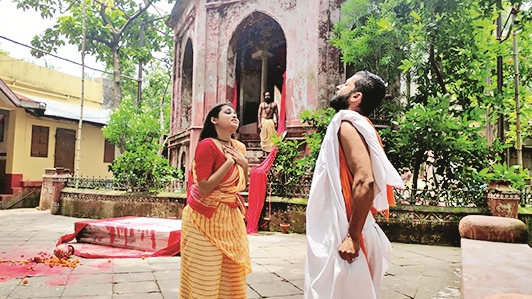Crisis has a strange bedfellow in innovation. With the coronavirus pandemic reaching the third phase and proscenium and other enclosed spaces out of bounds, West Bengal’s thespians have started embracing outdoor spaces. Some exciting works are being produced in the city’s outskirts. On the morning of July 12, Belgharia Hatekhori’s Bisarjan was played out in the precincts of Behari Lal Pyne Thakur Bari, a 19th century Vaishnava temple complex on the Ganga. Located in Sukchar, within 25 kilometres from the heart of Calcutta, this comes close to what we call promenade theatre.
Rabindranath Tagore’s Bisarjan formed the basis on which the dramaturge, Himadri Sekhar Dey, worked extensively, chopping and adding with an eye for an anti-fundamentalism tirade. The drama unfolded with an Urdu-speaking bhistiwallah washing the temple premises, only to be informed that his wife has suffered a miscarriage. The priest, Raghupati (Biswajit Das), enters the scene with the note of qurbani resonating in the audience’s ears. One must applaud the director, Debasish Ghosh Dastidar, for using every nook and cranny of the sprawling complex. With the doltala at the centre of the performance and the century-old temple as Raghupati’s seat of worship, the adjacent dilapidated quarter was turned into a dungeon, the natmandir verandah into a royal court, the banyan tree facing the temple became Jaisingha’s (Pritam Chakraborty) haven, and towards the end, when Raghupati throws the image into the waters, he goes down the steps leading to the Ganga with the symbolic trident in hand.
Tagore never prescribed realism for Bisarjan. Ghosh Dastidar’s way with symbols — for instance, long red clothes to indicate blood trails and symbolic corpses to hint at a killing field — worked well. The lead cast, alongside an expressive Abheepsa Ghosh playing Aparna, did reasonable justice to the drama. The pre-recorded background score jarred, as did the costumes. Why use Roman togas and synthetic saris when the lead trio dons traditional temple wear?
Postscript: The temple premises looked spick and span. The action was preceded by an almost ritualistic use of hand sanitizer. And the masked audience, including some casual bystanders, maintained physical distancing as they sat through the 90-minute-long show. Possibly an example to emulate.











